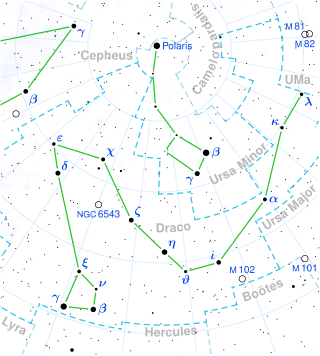Omicron Draconis
| Observation data Epoch J2000 Equinox J2000 | ||
|---|---|---|
| Constellation | Draco | |
| Right ascension | 18h 51m 12.09530s[1] | |
| Declination | +59° 23′ 18.0627″[1] | |
| Apparent magnitude (V) | 4.65[2] | |
| Characteristics | ||
| Spectral type | G9III[3] | |
| U−B color index | +1.19[2] | |
| Variable type | eclipsing[4]
| |
| Absolute magnitude (MV) | −0.344[6] | |
Semi-amplitude (K1)(primary) | 23.42 ± 0.05 km/s | |
| Semi-amplitude (K2) (secondary) | 32.0 ± 0.4 km/s | |
| Details | ||
| ο Dra A | ||
Gyr | ||
| ο Dra B | ||
| Mass | 0.99[4] M☉ | |
| Radius | 1.0[4] R☉ | |
| Luminosity | 1.3[4] L☉ | |
| Surface gravity (log g) | 4.43[4] cgs | |
| Temperature | 6,000[4] K | |
BD +59°1925 | ||
| Database references | ||
| SIMBAD | data | |
Omicron Draconis (Latinised as ο Draconis, abbreviated to ο Dra) is a
light years from the Earth. Its path in the night sky is circumpolar
for latitudes greater than 31o north, meaning the star never rises or sets when viewed in the night sky.

This is a single-lined
spectroscopic binary system,[7] but the secondary has been detected using interferometry. It is an RS Canum Venaticorum variable system with eclipses. The total amplitude of variation is only a few hundredths of a magnitude.[8][4] The secondary star is similar to the Sun, presumably a main sequence star, while the primary is a giant star
25 times larger than the Sun and two hundred times more luminous.
Identities as pole star
Omicron Draconis can be considered the north pole star of Mercury, as it is the closest star to Mercury's north celestial pole.[9] In addition to that, this star is currently the Moon's north pole star, which occurs once every 18.6 years.[10] The pole star status changes periodically, because of the precession of the Moon's rotational axis.
References
- ^ S2CID 18759600.
- ^ Bibcode:1991bsc..book.....H.
- ^ doi:10.1086/191373.
- ^ S2CID 119228345.
- S2CID 15290475.
- ^ doi:10.1086/317850.
- ^ S2CID 12361870
- ^ "omi Dra". The International Variable Star Index. AAVSO. Retrieved 15 July 2022.
- ^ Sharrah, Paul C. (1975). "Pole Stars of Other Planets" (pdf). Arkansas Academy of Sciences Proceedings. XXIX: 62–63.
- ^ Patrick Moore (1983), The Guinness Book of Astronomy Facts & Feats, p. 29,
In 1968 the north pole star of the Moon was Omega Draconis; by 1977 it was 36 Draconis. The south pole star is Delta Doradus.
External links
- 2004. ISBN 978-0-07-333666-4. www.starrynight.com

